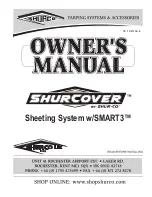
Transmission Fluid Temperature
Gauge
The transmission fluid temperature gauge indicates
the transmission lubricant operating temperature.
Temperatures vary by application, but the transmis-
sion fluid temperature gauge reading should not ex-
ceed 250°F (121°C).
Under heavy loads, such as when climbing steep
grades, temperatures that exceed the normal oil tem-
perature range for a short period are not unusual. If
the temperature returns to normal when the load de-
creases, there is no problem.
NOTICE
A sudden increase in transmission fluid tempera-
ture that is not caused by a load increase may
indicate mechanical failure. Bring the vehicle to a
safe stop and investigate the cause to prevent
further damage. Do not operate the vehicle until
the cause has been determined and corrected.
Turbocharger Boost Pressure Gauge
A turbocharger boost pressure gauge indicates the
pressure in the intake manifold, in excess of atmos-
pheric pressure, being created by the turbocharger.
Voltmeter
The voltmeter indicates the vehicle charging system
voltage when the engine is running and the battery
voltage when the engine is off. By monitoring the
voltmeter, the driver can stay aware of potential bat-
tery charging problems and have them fixed before
the batteries discharge enough to create starting diffi-
culties. Vehicles are equipped with either a voltmeter
gauge, or a digital voltmeter readout located on the
bottom line of the dash message center.
The voltmeter will normally show approximately 13.7
to 14.1 volts when the engine is running. The voltage
of a fully charged battery is 12.7 to 12.8 volts when
the engine is off. Battery voltage under 12.0 volts is
considered a low battery, and a completely dis-
charged battery will produce only about 11.0 volts.
If the voltmeter shows an undercharged or over-
charged condition for an extended period, have the
charging system and batteries checked at an autho-
rized Freightliner service facility.
On a vehicle equipped with a battery isolator system,
the voltmeter measures the average voltage of all the
batteries when the engine is running. When the en-
gine is off, the voltmeter shows only the isolated bat-
tery voltage and does not indicate the voltage of the
engine-starting batteries.
Controls
Controls and switches are listed here in alphabetical
order.
Axle Switches
Differential Lock Switch
The differential lock switch provides maximum trac-
tion for slippery conditions by forcing the wheels on
each drive axle governed by the switch to rotate to-
gether. Engagement can be at any speed, provided
the wheels are not slipping or spinning. See
Fig. 2.19
.
Interaxle Lock Switch
The interaxle lock, standard on all dual-drive ve-
hicles, is driver-actuated by means of a LOCK/
UNLOCK control valve switch. See
Fig. 2.19
. A red
indicator illuminates when the interaxle lock is en-
gaged.
NOTICE
The interaxle lock should only be engaged when
the vehicle is moving slowly at low throttle. En-
gagement at high speed or power can damage
the axle(s).
Do not permit rear wheels to spin freely for more
than ten seconds when traction is lost. Shift into
LOCK to prevent damage to interaxle and main
differentials.
Brake Controls
NOTE: See
Chapter 6
for detailed information
about brake systems.
Instruments and Controls Identification
2.18


































